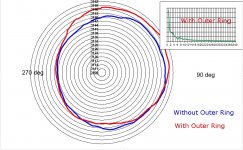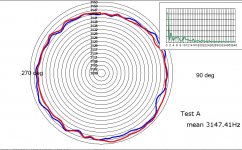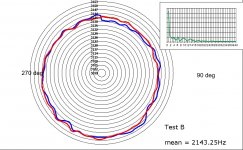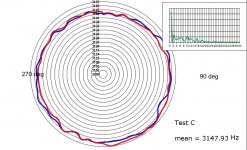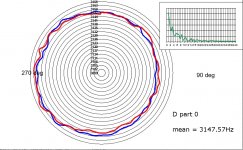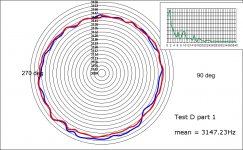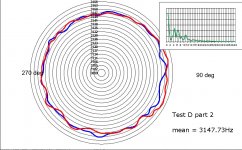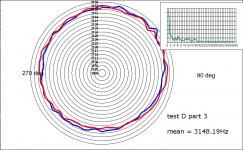Hi Jim, here's a polar plot for With-v-Without the outer ring, for your new belt recordings. Blue trace is 'without', Red trace is 'with' the outer ring.Hi LD,
I just received the new belt. Would you please do 2 plots for me? Thank you!
https://www.dropbox.com/s/3v0cnngu4mmuevv/new belt with ring.wav?dl=0
https://www.dropbox.com/s/axwcz8zyk1wluwv/new belt without ring.wav?dl=0
Jim
The 'without' trace is overall more stable, but unfortunately both still show the 'once per revolution' variation for part of the revolution which is still more pronounced when the outer ring is fitted.
So, unfortunately, it doesn't seem that the new belt has changed much: except (oddly) the 'with' recorded file is on average slightly faster than the 'without' - perhaps you reset the speed after fitting the ring?
Knowing the cart-arm resonances are about 4 Hz means one can look wisely at the FM spectrum and perhaps see some content there - but in the grand scheme of things it's not significant, and there are other factors which contribute much more to pitch stability. On the whole, apart from the once per revolution stuff, pitch stability is very good and the cart-arm looks good to me. It's better without the ring, methinks.
HTH!
LD
Attachments
Last edited:
Hi LD,
Thank you for doing the plots for me!
It seems to me the new belt doesn’t do too much to get rid of once per revolution frequency shift. It perhaps makes things worse. I compared the new plot with old one(old belt installed). The shift in frequencies from highest point to lowest point was 12 Hz with outer ring and was 10 Hz without outer ring. For new belt, the shift is 16 Hz with outer ring and 13 Hz without outer ring.
Yes. I reset the speed after installing the new belt with outer ring. It looks like that the speed doesn’t raise too much without the ring. In previous plots, the outer ring slowed the speed considerably. The only explanation is the new belt may increase the grabbing force so the speed difference is small now. From this point of view, the new belt does add some positive effect to the driving mechanism.
Jim
Thank you for doing the plots for me!
It seems to me the new belt doesn’t do too much to get rid of once per revolution frequency shift. It perhaps makes things worse. I compared the new plot with old one(old belt installed). The shift in frequencies from highest point to lowest point was 12 Hz with outer ring and was 10 Hz without outer ring. For new belt, the shift is 16 Hz with outer ring and 13 Hz without outer ring.
Yes. I reset the speed after installing the new belt with outer ring. It looks like that the speed doesn’t raise too much without the ring. In previous plots, the outer ring slowed the speed considerably. The only explanation is the new belt may increase the grabbing force so the speed difference is small now. From this point of view, the new belt does add some positive effect to the driving mechanism.
Jim
A few years back there was a collaborative test to investigate possible effect of stylus drag on speed stability using polar plots.
The catch 22 challenge is that the 3150Hz test tone is continuous, so would drag be.
Someone came up with this ingenious test, and I have the exact notes he wrote from that test :
IIRC the result concluded no significant effect of stylus drag variation, but I still have the test files, so will re-run them and post the outcomes as polar plots.
LD
The catch 22 challenge is that the 3150Hz test tone is continuous, so would drag be.
Someone came up with this ingenious test, and I have the exact notes he wrote from that test :
OK, I've done four recordings in an attempt to look at the effects of stylus drag.
A second arm and cartridge was set up so that they could be used to track the test record simultaneously to the main arm and cartridge (the extra arm was an SME 3009II Improved with a Shure V15mkIV).
Each track includes 3 seconds of silent groove prior to the start of the test tone, for alignment purposes (hope that helps).
A is just my arm and cartridge playing the test track (no added drag).
B is with the Shure stylus also tracking the record (track 1).
C is with the Shure stylus damper brush also engaged (for added drag).
D is as C, but the arm is lifted mid way through the recording.
A second arm and cartridge was set up so that they could be used to track the test record simultaneously to the main arm and cartridge (the extra arm was an SME 3009II Improved with a Shure V15mkIV).
Each track includes 3 seconds of silent groove prior to the start of the test tone, for alignment purposes (hope that helps).
A is just my arm and cartridge playing the test track (no added drag).
B is with the Shure stylus also tracking the record (track 1).
C is with the Shure stylus damper brush also engaged (for added drag).
D is as C, but the arm is lifted mid way through the recording.
IIRC the result concluded no significant effect of stylus drag variation, but I still have the test files, so will re-run them and post the outcomes as polar plots.
LD
Someone came up with this ingenious test
Kudos to him. Ingenious indeed.

George
Guys, take a moment to set aside your test LP’s, polar plots, etc., and just listen to this audio clip with your ears. A friend of mine sent me this link on YouTube which captures the audible effects of transient FM distortion when a cartridge/tonearm combination encounters a sharp record warp. The video clearly demonstrates the warble-like distortion that happens when the arm/cartridge bobs around vertically and horizontally and causes the stylus tip to ‘scrub’ along the groove, effectively causing dynamic pitch instability that is not related to the design of the turntable drive system. Would putting this particular LP + arm + cartridge combination on a $50K turntable make it sound better? I think not.
https://www.youtube.com/watch?v=Tvne7oypwiQ
Ray K
https://www.youtube.com/watch?v=Tvne7oypwiQ
Ray K
Ray: I think we are all in violent agreement on this. But it's still fun to look at all aspects of things. What is interesting is how much this is ignored. I see on ebay a few townsend rock turntables come up and they do not sell for very much compared to other names from the 80s.
I think there is much to rediscover that was known and then lost
I think there is much to rediscover that was known and then lost
It took some time to run the polar plots, and I repeated them to make sure because there's an odd result in that recordings C and D generally are faster than B.........A few years back there was a collaborative test to investigate possible effect of stylus drag on speed stability using polar plots.
The catch 22 challenge is that the 3150Hz test tone is continuous, so would drag be.
Someone came up with this ingenious test, and I have the exact notes he wrote from that test :
OK, I've done four recordings in an attempt to look at the effects of stylus drag.
A second arm and cartridge was set up so that they could be used to track the test record simultaneously to the main arm and cartridge (the extra arm was an SME 3009II Improved with a Shure V15mkIV).
Each track includes 3 seconds of silent groove prior to the start of the test tone, for alignment purposes (hope that helps).
A is just my arm and cartridge playing the test track (no added drag).
B is with the Shure stylus also tracking the record (track 1).
C is with the Shure stylus damper brush also engaged (for added drag).
D is as C, but the arm is lifted mid way through the recording.
IIRC the result concluded no significant effect of stylus drag variation, but I still have the test files, so will re-run them and post the outcomes as polar plots.
LD
Anyway, here's the polar plots. As usual, Red and Blue traces are two successive revolutions.
Test D is split into 3 parts that span 6 successive revolutions around the middle of the test recording where the transition is said to be. I don't know where the transition is, BTW, but the test tone is genuinely about 0.03% faster at the end of that recording than the beginning.
If there is a transition in Test D, it is very small and swamped by other normal random pitch variations probably caused by headshell movement IMO.
There is a notable difference between Tests A and B in terms of overall speed: a slowing of about 0.15% which bodes well for the method, but the change was reversed in Test C (surprisingly?), and no transition was detectable in Test D, other than an overall very small speed increase at the end of the file versus the beginning of about 0.03%.
Thoughts ?
LD
Attachments
Yes - 0.03% difference being between averages of two 4s samples separated by about 30s - with the 2nd arm lifted in between. Mains f alone or other random events might well explain such small deviation, methinks.0.03% sounds to be within limits for voltage fluctuation in a domestic supply (for example fridge cycling). Unless the TT had a regulated DC supply I would put that well within error bands!
I think the point is that, in test D, not only was the 2nd arm lift drag reduction event difficult to detect (I think perhaps about 3 o'clock on Test D part 2 ?), the deviation was small, short lived, and swamped by other more significant short term random events in the scheme of things.
In other words, in Test D platter speed wasn't affected by stylus drag from the 2nd stylus to any meaningful extent.
That is not to say that programme modulation doesn't affect FM stability - it's just that the mechanism is via headshell movement rather than platter rotation speed variation...............(!)
LD
Last edited:
My 2p worth as to mains-frequency type variation is that, by definition, it changes slowly and therefore isn't normally perceivable by most people - only a tiny few could resolve absolute pitch to within about 1/5 of a semitone (about 1% of frequency).
What is far more audible is relatively sudden change in pitch of a tone, such as warble or vibrato. The FM range as to threshold of audibility for step changes of a tone works out about 5 musical cents, or about +/- 0.15% of frequency, and some people even finer AFAIK. Particularly warble in the range 0.5Hz-30Hz, and especially if it modulates a natural or familiar sound.
So, IMO, focus on motor speed absolute accuracy is a distraction, though it's harmless. Short term variations by way of wow and vibrato matter far more to audibility, and in most cases where it occurs very simple mechanical faults dominate IME. In normal and otherwise healthy TTs, once per revolution variation and cart-arm stability dominate causes, even though mains frequency variation might numerically far exceed it in principle: we're not wired up to hear it......
LD
What is far more audible is relatively sudden change in pitch of a tone, such as warble or vibrato. The FM range as to threshold of audibility for step changes of a tone works out about 5 musical cents, or about +/- 0.15% of frequency, and some people even finer AFAIK. Particularly warble in the range 0.5Hz-30Hz, and especially if it modulates a natural or familiar sound.
So, IMO, focus on motor speed absolute accuracy is a distraction, though it's harmless. Short term variations by way of wow and vibrato matter far more to audibility, and in most cases where it occurs very simple mechanical faults dominate IME. In normal and otherwise healthy TTs, once per revolution variation and cart-arm stability dominate causes, even though mains frequency variation might numerically far exceed it in principle: we're not wired up to hear it......
LD
Thanks for the tests, Lucky.  As sensitive as you test is I am surprised that the arm lift wasn't obvious.
As sensitive as you test is I am surprised that the arm lift wasn't obvious.
I remember back when CDs started to become common a number of music loves claimed a great improvement for piano recordings with the speed stability of digital. Some things we are more sensitive to than others.
 As sensitive as you test is I am surprised that the arm lift wasn't obvious.
As sensitive as you test is I am surprised that the arm lift wasn't obvious.I remember back when CDs started to become common a number of music loves claimed a great improvement for piano recordings with the speed stability of digital. Some things we are more sensitive to than others.
Yes - the polar plot is well capable of detecting the arm lift and resolving any frequency change with more than enough resolution and accuracy. One might reasonably conclude it wasn't meaningfully there, IMO.Thanks for the tests, Lucky.As sensitive as you test is I am surprised that the arm lift wasn't obvious.
I remember back when CDs started to become common a number of music loves claimed a great improvement for piano recordings with the speed stability of digital. Some things we are more sensitive to than others.
As to why not, it's very difficult to say with historic files, as we can't ask questions and I don't even know the time mark where the change should be. It's not the only odd thing: test B (brush up) is slower than test C (brush down)..........
So, it could be methodology. For sure though, we can say the platter really didn't change speed much or abnormally in the test D recording..............
And yes, solo piano really can show the good bad and ugly of pitch variation.
LD
Last edited:
Would that suggest that damper brush does work ? in B when second arm was put it stimulated resonance and slowed the speed* . But in C with the damper engaged** that resonance was bought down. Possible ?There is a notable difference between Tests A and B in terms of overall speed: a slowing of about 0.15% which bodes well for the method, but the change was reversed in Test C (surprisingly?), and no transition was detectable in Test D, other than an overall very small speed increase at the end of the file versus the beginning of about 0.03%.
Thoughts ?
LD
*(if you had quartz direct drive or synchronous belt motor B would not have slowed down. Right ?)
** This was the only change you made so logically it might be the cause ?
Regards
Last edited:
One can approach test D theoretically (spherical cow alert):
Assume test track radius r = 0.1m, uniform platter mass m = 2kg, platter radius = R = 0.18m, VTF = 1gf = 0.01N, friction coefficient k = 0.3
Step change in torque when arm is lifted dT = VTF * k * r = 0.001 Nm
Angular acceleration A if platter were free = ((m*R^2)/2) * dT = 0.00001 radians/s^2
Therefore in one second, angular velocity would decrease by 0.00001 rads/sec
33.333rpm = 3.5 radians/sec
Then anticipated change in frequency due to the armlift would be 0.00001/3.5 ie about 0.0003% if the platter were free.
Then, although the method is good, the result correctly confirms there should be no observable change in platter rotation speed in test D.
The spherical cow has spoken.
Suggest double check it, just in case of gaff, and I am surprised............ !?
LD
Assume test track radius r = 0.1m, uniform platter mass m = 2kg, platter radius = R = 0.18m, VTF = 1gf = 0.01N, friction coefficient k = 0.3
Step change in torque when arm is lifted dT = VTF * k * r = 0.001 Nm
Angular acceleration A if platter were free = ((m*R^2)/2) * dT = 0.00001 radians/s^2
Therefore in one second, angular velocity would decrease by 0.00001 rads/sec
33.333rpm = 3.5 radians/sec
Then anticipated change in frequency due to the armlift would be 0.00001/3.5 ie about 0.0003% if the platter were free.
Then, although the method is good, the result correctly confirms there should be no observable change in platter rotation speed in test D.
The spherical cow has spoken.
Suggest double check it, just in case of gaff, and I am surprised............ !?
LD
OOooops, just spotted the mistake.......here's the correction:One can approach test D theoretically (spherical cow alert):
Assume test track radius r = 0.1m, uniform platter mass m = 2kg, platter radius = R = 0.18m, VTF = 1gf = 0.01N, friction coefficient k = 0.3
Step change in torque when arm is lifted dT = VTF * k * r = 0.001 Nm
Angular acceleration A if platter were free = ((m*R^2)/2) * dT = 0.00001 radians/s^2
Therefore in one second, angular velocity would decrease by 0.00001 rads/sec
33.333rpm = 3.5 radians/sec
Then anticipated change in frequency due to the armlift would be 0.00001/3.5 ie about 0.0003% if the platter were free.
Then, although the method is good, the result correctly confirms there should be no observable change in platter rotation speed in test D.
The spherical cow has spoken.
Suggest double check it, just in case of gaff, and I am surprised............ !?
LD
Angular acceleration A if platter were free = dT/((m*R^2)/2) = 0.03 radians/s^2
Therefore in one second, angular velocity would increase by 0.03 rads/sec
33.333rpm = 3.5 radians/sec
Then anticipated change in frequency over the course of 1s after the armlift would be 0.03/3.5 ie about 0.9% over the course of 1s if the platter were free. Which would be notable.
However, the platter isn't free. It's driven by a motor/drive system which would accommodate changes in torque/speed. So I think all we can say is that the speed change over 1s would be less than 0.9%.
So I think I'd expect to see something on the polar plot, albeit a slow event and small in magnitude, as the inertia of the platter prevents fast changes and the drive system should accommodate torque changes......
LD
Last edited:
- Status
- This old topic is closed. If you want to reopen this topic, contact a moderator using the "Report Post" button.
- Home
- Source & Line
- Analogue Source
- Turntable speed stabilty
